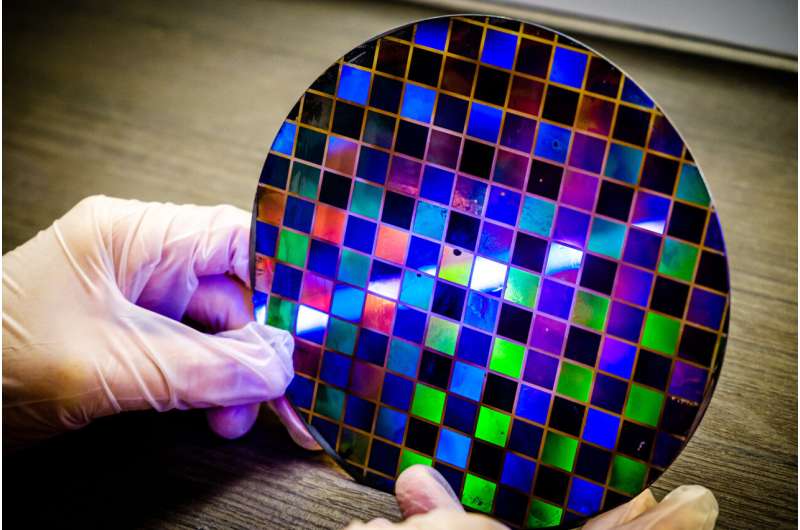Scientists devise new technique to increase chip yield from semiconductor wafer

Scientists from the Nanyang Technological University, Singapore (NTU Singapore) and the Korea Institute of Machinery & Materials (KIMM) have developed a technique to create a highly uniform and scalable semiconductor wafer, paving the way to higher chip yield and more cost-efficient semiconductors.
Semiconductor chips commonly found in smart phones and computers are difficult and complex to make, requiring highly advanced machines and special environments to manufacture.
Their fabrication is typically done on silicon wafers and then diced into the small chips that are used in devices. However, the process is imperfect and not all chips from the same wafer work or operate as desired. These defective chips are discarded, lowering semiconductor yield while increasing production cost.
The ability to produce uniform wafers at the desired thickness is the most important factor in ensuring that every chip fabricated on the same wafer performs correctly.
Nanotransfer-based printing—a process that uses a polymer mold to print metal onto a substrate through pressure, or "stamping"—has gained traction in recent years as a promising technology for its simplicity, relative cost-effectiveness, and high throughput.
However, the technique uses a chemical adhesive layer, which causes negative effects, such as surface defects and performance degradation when printed at scale, as well as human health hazards. For these reasons, mass adoption of the technology and consequent chip application in devices has been limited.
In their study, which was published in the peer-reviewed journal ACS Nano, the research team from NTU and KIMM reported that their chemical-free printing technique, when combined with metal-assisted chemical etching—a method used to enhance the contrast on surfaces to make nanostructures visible—resulted in semiconductor wafers with nanowires (nanostructures in cylindrical form) that were highly uniform and scalable. The semiconductor also demonstrated better performance when compared with current chips in the market. Moreover, the fabrication method is also fast and leads to high chip yield.
The study is an example of ground-breaking research that supports the NTU 2025 strategic plan, which seeks to address humanity's grand challenges and accelerate the translation of research discoveries into innovations that mitigate impact on the environment and on the human health.
New chemical-free printing technique leads to high chip yield
The newly developed nanotransfer printing technique developed by NTU and KIMM is accomplished by transferring Gold (Au) nanostructure layers onto a Silicon (Si) substrate at low temperature (160°C) to form a highly uniform wafer with nanowires that can be controlled to the desired thickness during fabrication.
The printing technique, which is chemical-free, works by triggering direct chemisorption of the thin metal films under heat—a chemical reaction that creates a strong bond between a substrate surface and the substance that is adsorbed.
This industrial compatible technique allows a wafer to be fabricated quickly and uniformly at scale (from nanometers to inches). At the same time, the fabricated wafer is almost defect-free, meaning that little to no chip are discarded due to poor performance.
In lab tests, the joint research team was able to achieve more than 99 percent yield transfer of a 20-nanometre thick Au film onto a six-inch Si wafer. This printable wafer size was limited to the laboratory setup, and the NTU-KIMM team believes their technique can easily be scaled up for use on a twelve-inch wafer—the mainstream wafer size in the current production lines of semiconductor chipmakers like Samsung, Intel and GlobalFoundries.
When the method was adopted to fabricate a six-inch wafer, results showed the printed layer remained intact with minimal bending during etching—a process that commonly cause layers to separate—demonstrating the outstanding uniformity and stability of the technique developed by NTU and KIMM.
Furthermore, when 100 light sensors, known as photodetectors, were fabricated into the six-inch wafer, excellent uniformity of performance was achieved, underlining its excellent potential for the technique to be used in commercial mass production.
Technique opens door to lower cost semiconductor chip
Co-lead researcher, NTU Assistant Professor Kim Munho from the School of Electrical and Electronic Engineering said the uniformity, scalability and stability of the team's technique overcomes the main bottleneck present in existing nanotransfer printing methods.
The achievement by the NTU and KIMM research team in developing a method to manufacture semiconductor chips more cost-effectively could lead to significant advances in electronics and light-based devices added Kim.
"The technique devised by the research team from NTU and KIMM has proven to be effective in creating wafer with excellent uniformity, which translates into fewer defective semiconductor chips. The reality of global chip supply is its vulnerability to many external factors, including shortage of materials and unexpected events like the supply chain disruptions caused by the COVID-19 pandemic. Our newly developed method thus has potential to relieve the tension on the global chip supply in future by increasing chip yield. Moreover, chip makers may also enjoy greater cost-efficiency with higher yields," said Kim.
Highlighting the significance of the work, co-lead author Dr. Jeong Jun-Ho, Principal Researcher from the Nano-Convergence Manufacturing Systems Research Division at KIMM, said, "The technique developed by the NTU-KIMM team is a new concept of low-cost mass production technology for highly uniform and scalable semiconductor nanostructures, which can be applied to the mass production of nanophotonics, high performance nano-solar cells, next-generation secondary batteries and others."
More information: Zhi-Jun Zhao et al, Direct Chemisorption-Assisted Nanotransfer Printing with Wafer-Scale Uniformity and Controllability, ACS Nano (2022). DOI: 10.1021/acsnano.1c06781





















